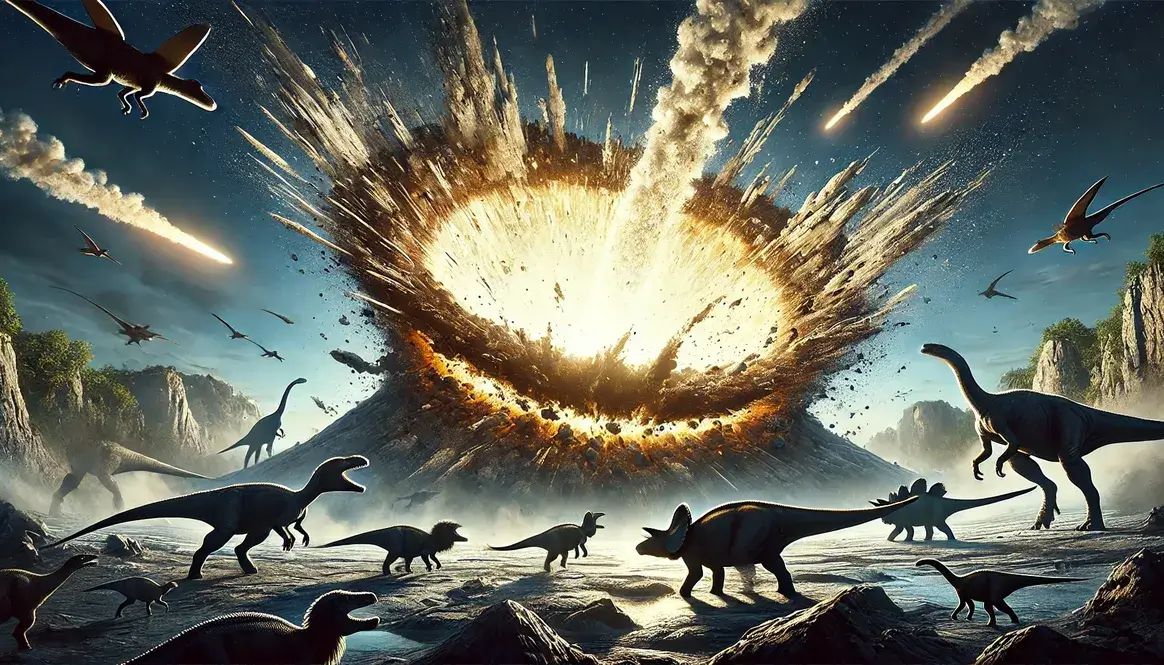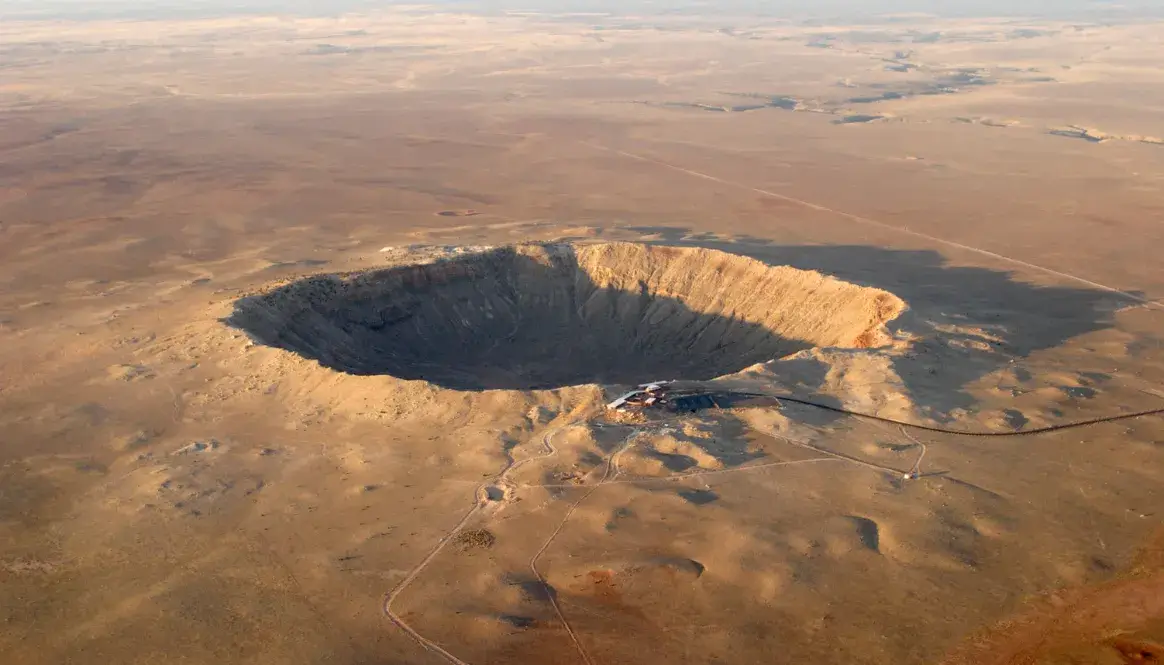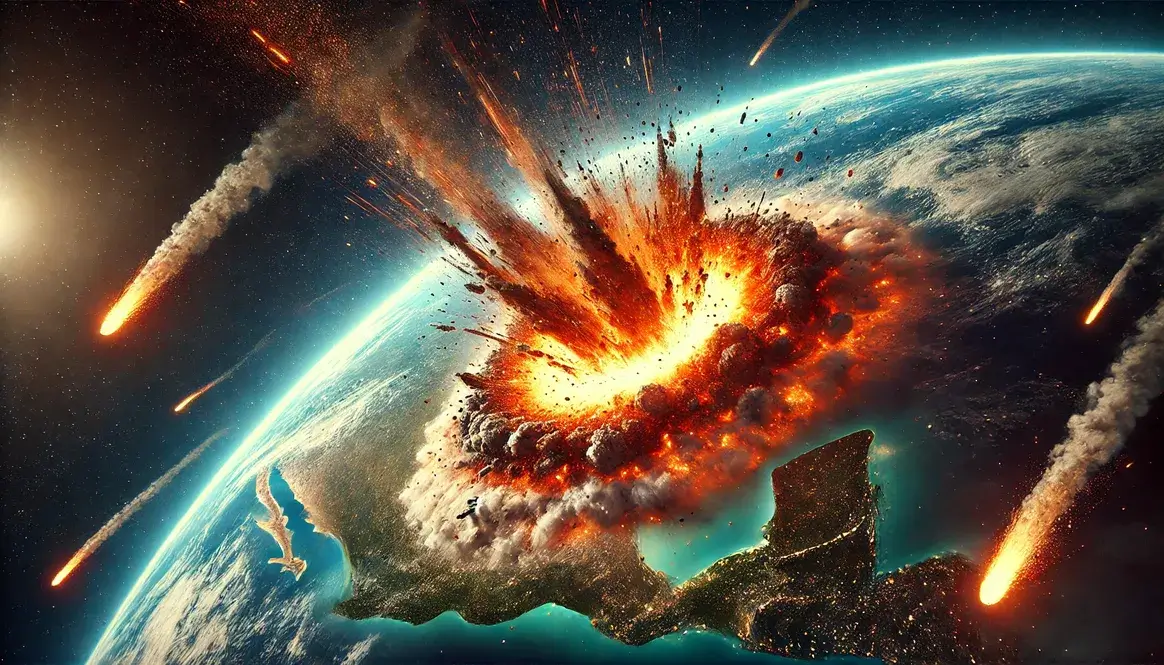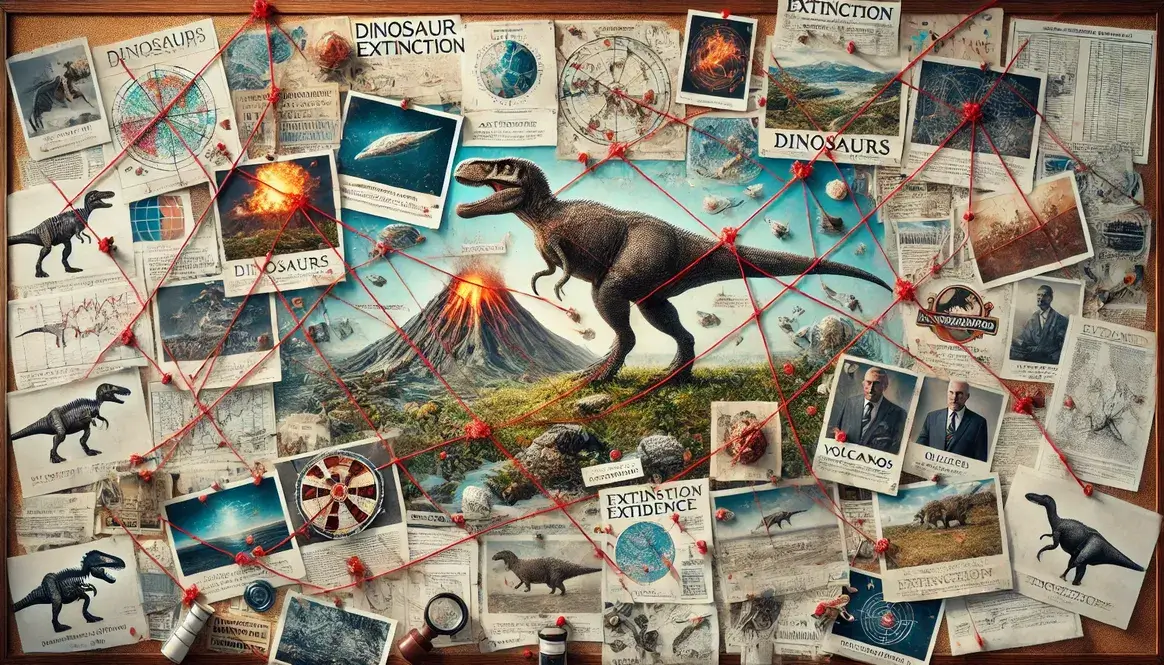About 66 million years ago, a massive space rock slammed into Earth. This wasn’t just any ordinary impact – it was a world-changing event that marked the end of the dinosaurs’ reign. Known as the Chicxulub impact, this cosmic collision left behind a giant scar on our planet and reshaped life as we know it.
The Chicxulub crater dinosaur extinction event is key to understanding why these amazing creatures vanished after ruling Earth for over 160 million years. It’s a story of cosmic bad luck, global devastation, and the resilience of life in the face of catastrophe.
Chicxulub Crater Dinosaur Extinction: The Smoking Gun
The Chicxulub crater is a massive, buried impact crater located on the Yucatán Peninsula in Mexico. It’s named after the nearby town of Chicxulub. This crater isn’t your average hole in the ground – it’s about 150 kilometers (93 miles) wide and 20 kilometers (12 miles) deep!
To give you an idea of its size, imagine a hole as wide as the distance between New York City and Philadelphia, and deep enough to swallow the tallest skyscraper 20 times over. That’s the Chicxulub crater!
| Chicxulub Crater Stats | Measurements |
|---|---|
| Diameter | 150 km (93 miles) |
| Depth | 20 km (12 miles) |
| Age | About 66 million years |
Scientists didn’t always know about this massive crater. Its discovery is a fascinating tale of scientific detective work. In the late 1970s, geophysicists Antonio Camargo and Glen Penfield were looking for oil in the Gulf of Mexico. They found strange circular patterns in their geological data but couldn’t explain them at the time.
It wasn’t until 1990 that scientists connected the dots. They linked this mysterious circular feature to the theory of asteroid impact causing dinosaur extinction. This connection turned the Chicxulub crater into the smoking gun of the dinosaur extinction mystery.
The identification of Chicxulub as an impact site was a game-changer. It provided strong evidence for the idea that a massive asteroid strike could have caused the mass extinction that wiped out the dinosaurs. This discovery reshaped our understanding of Earth’s history and the forces that can alter life on a global scale.
Unearthing the Evidence
When scientists started digging into the Chicxulub crater, they found a treasure trove of evidence supporting its impact origin. The crater’s structure itself tells a compelling story. It features a central peak ring, typical of large impact craters, formed when rock rebounded after the initial impact.
But the real clincher came from some tiny crystals called shocked quartz. These aren’t your average quartz crystals. The immense pressure from the impact changed their structure in a way that only happens during meteorite strikes or nuclear explosions. Finding shocked quartz was like discovering the asteroid’s fingerprints at the crime scene!
Other impact markers found at Chicxulub include:
- Tektites: Small, glass-like objects formed from rock melted by the impact
- Iridium-rich layer: A thin layer of sediment enriched with this rare element, common in asteroids but scarce on Earth
- Melt rocks: Rocks that were melted and then rapidly cooled due to the extreme heat of impact
Dating the Chicxulub crater was crucial to linking it with the dinosaur extinction. Scientists used a method called radiometric dating, which measures the decay of radioactive elements in rocks. This technique pinpointed the crater’s age to about 66 million years – exactly when the dinosaurs met their end!
Connecting the Crater to Mass Extinction
The timing of the Chicxulub impact lines up perfectly with what geologists call the K-Pg boundary. This boundary marks the end of the Cretaceous period (K) and the beginning of the Paleogene period (Pg). It’s like a line in the rock record separating the age of dinosaurs from the age of mammals.
One of the most compelling pieces of evidence linking the Chicxulub impact to mass extinction is the global iridium layer. Iridium is rare on Earth but common in asteroids. After the impact, a thin layer of iridium-rich dust spread around the world. Scientists have found this layer at hundreds of sites across the globe, always right at the K-Pg boundary.
| Evidence | Description | Significance |
|---|---|---|
| K-Pg Boundary | Geological layer marking the end of the Cretaceous | Coincides with Chicxulub impact date |
| Iridium Layer | Thin, worldwide layer rich in asteroid material | Indicates global effects of impact |
| Fossil Record | Sudden disappearance of many species | Shows mass extinction event |
The dinosaur fossil record tells a stark story. Dinosaur fossils are abundant in rock layers below the K-Pg boundary but vanish abruptly at this line. It’s as if someone turned off the dinosaur switch. This pattern is seen worldwide, strongly suggesting a sudden, global extinction event.
The Chicxulub crater dinosaur extinction theory ties all these pieces together. The impact date matches the K-Pg boundary, the iridium layer shows its global reach, and the fossil record reveals its devastating effects. It’s a scientific detective story where all the clues point to one cosmic culprit!
The Devastating Effects of the Chicxulub Impact
The Chicxulub crater dinosaur extinction event unleashed a series of catastrophic consequences that reshaped our planet. These effects, both immediate and long-lasting, turned Earth into a hostile environment for many life forms, especially the dinosaurs.
Initial Shockwave and Earthquakes
When the asteroid slammed into Earth, it released energy equivalent to billions of atomic bombs. This immense force generated a shockwave that rippled across the planet. Imagine dropping a pebble in a pond, but instead of gentle ripples, you get waves that could flatten mountains!
The impact triggered earthquakes far more powerful than anything we experience today. These mega-quakes would have:
- Toppled trees thousands of miles from the impact site
- Caused landslides and reshaped landscapes
- Generated tsunamis in nearby oceans
In the immediate vicinity of the Chicxulub crater, the destruction was total. The asteroid vaporized instantly, along with tons of rock from the impact site. This created a temporary hole in the atmosphere, allowing superheated material to escape into space before raining back down on Earth.
Global Wildfires
One of the most dramatic effects of the Chicxulub asteroid impact was the outbreak of global wildfires. As debris from the impact reentered the atmosphere, it heated up due to friction, turning the sky into a giant broiler.
Evidence for these widespread fires comes from several sources:
- Soot and charcoal in K-Pg boundary rock layers
- Fossilized burned plants from the time period
- Chemical signatures of large-scale burning in sediments
These fires had a devastating impact on terrestrial ecosystems. Forests burned, and with them, the habitats of countless species. Many plants and animals that survived the initial impact likely perished in the global inferno that followed.
The smoke and ash from these fires added to the debris already thrown into the atmosphere by the impact. This created a thick layer of particles in the sky, blocking out sunlight and setting the stage for even more long-term effects on Earth’s climate and ecosystems.
Tsunami and Marine Ecosystem Disruption
The Chicxulub impact didn’t just shake the land – it created massive waves in the oceans. When the asteroid hit, it displaced huge amounts of water, generating tsunamis of unimaginable size. These weren’t your typical big waves; we’re talking about walls of water hundreds of meters high!
These monster tsunamis raced across the oceans, slamming into coastlines around the world. The destruction was immense:
- Coastal areas were completely submerged
- Sediment was churned up and redeposited
- Marine life was tossed onto land, and land animals were swept out to sea
The shallow marine habitats, home to diverse ecosystems, were hit particularly hard. Coral reefs were smashed, sea grass meadows uprooted, and countless marine creatures were killed or displaced. This marine ecosystem collapse had long-lasting effects on ocean food webs and biodiversity.
Dust and Aerosols: The Impact Winter
As if tsunamis weren’t bad enough, the Chicxulub crater dinosaur extinction event also kicked off a period known as the “impact winter.” Here’s how it happened:
- The impact vaporized rock and threw enormous amounts of dust and aerosols into the atmosphere.
- This debris spread globally, forming a thick layer that blocked out sunlight.
- Without sunlight, Earth’s surface began to cool rapidly.
This global cooling lasted for months or even years. Temperatures plummeted, possibly dropping by as much as 26°C (47°F) globally. Imagine a world where it’s always cloudy, always cold, and plants struggle to grow. That’s what the impact winter was like.
The effects on plant life were devastating. Without sunlight, photosynthesis nearly stopped. Plants withered and died, and with them went the base of the food chain. Herbivores, having lost their food source, began to starve. Carnivores soon followed as their prey disappeared. It was a domino effect that toppled ecosystems worldwide.
Long-term Climate Change
While the impact winter was bad news for life on Earth, it wasn’t the end of the climate chaos. The Chicxulub impact had more tricks up its sleeve:
- Greenhouse gas release: The asteroid hit an area rich in carbonate rocks. When vaporized, these rocks released massive amounts of carbon dioxide into the atmosphere.
- Global warming phase: After the impact winter, all this extra CO2 led to a period of rapid global warming. Temperatures soared, possibly rising by 5°C (9°F) above pre-impact levels.
- Ocean acidification: Much of the CO2 was absorbed by the oceans, making them more acidic. This was particularly tough on marine life with calcium carbonate shells or skeletons.
These rapid swings between extreme cold and extreme heat were a one-two punch for surviving species. Organisms that managed to endure the freezing impact winter now had to contend with sweltering heat.
The ecosystems that emerged after this climatic rollercoaster looked very different from those before. Many niches left empty by extinct species were filled by survivors that could adapt quickly. This paved the way for the rise of new dominant groups, including our own ancestors – the mammals.
The Chicxulub impact’s long-term climate effects reshaped Earth’s biosphere, setting the stage for the world we know today. It’s a stark reminder of how a single event can have consequences that echo through millions of years of Earth’s history.
From Impact to Extinction: Connecting the Dots
The Chicxulub crater dinosaur extinction event wasn’t a simple case of an asteroid hitting Earth and instantly wiping out all dinosaurs. Instead, it set off a chain reaction of environmental changes that made survival incredibly challenging for many species. Let’s piece together how this cosmic collision led to one of the most significant mass extinctions in Earth’s history.
Disruption of Food Chains
At the heart of the extinction was a massive disruption of food chains, starting from the bottom up. Here’s how it unfolded:
- Plant life collapse: The impact winter blocked sunlight, causing widespread plant death. Without their energy source, plants couldn’t photosynthesize and began to die off en masse.
- Herbivore starvation: With plants dying, herbivores lost their food source. Large dinosaurs, which needed to eat tons of plant matter daily, were hit particularly hard.
- Carnivore decline: As herbivore populations dwindled, carnivores found themselves without prey. Even the mighty T. rex couldn’t escape this fate.
This cascade effect rippled through ecosystems worldwide. Imagine a game of Jenga – the Chicxulub impact pulled out the bottom blocks (plants), and the whole tower came tumbling down.
But it wasn’t just dinosaurs affected. The collapse of marine food chains was equally devastating. Tiny photosynthetic plankton, the base of ocean food webs, died off when sunlight was blocked. This led to the extinction of many marine species, from small fish to giant marine reptiles.
Selective Extinction Patterns
One of the most intriguing aspects of the Chicxulub crater dinosaur extinction is that it wasn’t uniform across all species. Some groups were hit harder than others, and a few even managed to thrive in the post-impact world.
Why non-avian dinosaurs went extinct:
- Large body size: Bigger dinosaurs needed more food and were less able to hide or hibernate.
- Specialized diets: Many dinosaurs had specific dietary needs that couldn’t be met in the changed environment.
- Long maturation times: Dinosaurs that took years to reach adulthood couldn’t adapt quickly enough to the rapid changes.
Survival of birds and mammals:
On the flip side, some groups weathered the storm better. Birds, the descendants of certain dinosaur lineages, survived. Their smaller size, ability to fly, and varied diets gave them an edge. Many could eat seeds, which remained viable food sources even when living plants were scarce.
Mammals also made it through, thanks to several advantages:
- Small size: Needed less food and could hide more easily
- Burrowing abilities: Some could shelter underground
- Varied diets: Many could eat a wide range of foods, including insects that survived the impact
It’s worth noting that while these groups survived, they didn’t come through unscathed. Many bird and mammal species still went extinct, but enough survived to repopulate and diversify in the post-dinosaur world.
The selective nature of this extinction event reshaped the planet’s biodiversity. It cleared the way for surviving groups to evolve and diversify, eventually leading to the rise of mammals and the emergence of humans. In a way, the Chicxulub crater dinosaur extinction set the stage for our own existence!
The Chicxulub Crater’s Role in Shaping Modern Extinction Theory
The discovery of the Chicxulub crater didn’t just solve a prehistoric mystery; it revolutionized our understanding of extinction events. This giant scar on Earth’s surface became a cornerstone in modern paleontology and geology, reshaping theories about how life on our planet can change dramatically in the blink of a geological eye.
Bolstering the Impact Hypothesis
Before the Chicxulub crater was found, many scientists believed dinosaurs went extinct gradually over millions of years. The crater’s discovery flipped this idea on its head, providing solid evidence for a catastrophic event.
This shift from gradual to catastrophic extinction models was huge. It showed that:
- Earth’s history isn’t always about slow, steady changes
- Single events can have global, long-lasting impacts
- Life on Earth is more fragile than we thought
But the Chicxulub crater dinosaur extinction theory didn’t exist in a vacuum. Scientists had to figure out how it fit with other ideas about what killed the dinosaurs. One big question was how it related to the Deccan Traps volcanism, massive volcanic eruptions happening around the same time in India.
Instead of competing theories, researchers now see these as complementary. The current thinking goes something like this:
- Deccan Traps volcanism stressed ecosystems over time
- The Chicxulub impact delivered the knockout blow
- Together, they created a “perfect storm” for mass extinction
This integration of multiple factors shows how complex Earth’s history can be. It’s rarely just one thing that causes big changes – it’s often a combination of events that push life to its limits.
Ongoing Research and Debates
Even though we know a lot about the Chicxulub crater and its effects, scientists haven’t stopped digging (literally and figuratively). Current research is focusing on:
- Detailed analysis of crater core samples
- Computer modeling of the impact and its aftermath
- Studying how life recovered after the extinction
One exciting area of study is looking at the crater’s peak ring, a circle of hills inside the main crater. By studying these rocks, scientists can learn more about the immense forces involved in the impact and how the Earth responded.
But there are still plenty of questions keeping researchers up at night:
- How quickly did different ecosystems collapse after the impact?
- Why did some species survive while others went extinct?
- Could we predict or prevent a similar event in the future?
These ongoing debates and studies show that science is always evolving. Each new discovery about the Chicxulub crater adds another piece to the puzzle of Earth’s history.
Legacy of the Chicxulub Impact: A New Era on Earth
The Chicxulub crater dinosaur extinction event marks a pivotal moment in Earth’s history. It’s like a reset button was hit on life on Earth, paving the way for new species to evolve and thrive.
After the dust settled (quite literally), mammals found themselves in a world of opportunity. With the giant dinosaurs gone, these small, furry creatures began to diversify and grow. They filled ecological niches left empty by the extinct species, eventually evolving into the diverse array of mammals we see today – including us!
This event teaches us some crucial lessons about extinction and evolution:
- Opportunity from catastrophe: Major extinctions, while devastating, can create opportunities for surviving species.
- Adaptability is key: The creatures that survived were often those that could adapt quickly to new conditions.
- Size isn’t everything: Sometimes, being small and versatile is more advantageous than being big and specialized.
Understanding the Chicxulub impact and its aftermath also gives us insight into current and future extinction risks. Today, we’re facing what some scientists call the sixth mass extinction, driven largely by human activities. By studying how life responded to past extinctions, we might better understand how to mitigate current biodiversity losses.
The Chicxulub crater serves as a stark reminder of our planet’s violent past and the fragility of life. But it also showcases life’s incredible resilience. After all, if life could bounce back from an asteroid strike, it gives us hope for the future of our planet’s biodiversity – as long as we learn from the past and take action to protect it.









